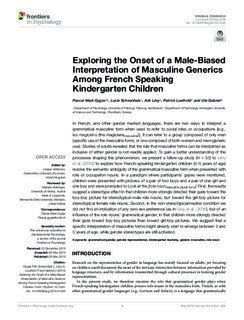| dc.contributor.author | Gygax, Pascal M. | |
| dc.contributor.author | Schoenhals, Lucie | |
| dc.contributor.author | Levy, Arik | |
| dc.contributor.author | Luethold, Patrick | |
| dc.contributor.author | Gabriel, Ute | |
| dc.date.accessioned | 2019-09-24T07:44:14Z | |
| dc.date.available | 2019-09-24T07:44:14Z | |
| dc.date.created | 2019-05-09T09:10:20Z | |
| dc.date.issued | 2019 | |
| dc.identifier.citation | Frontiers in Psychology. 2019, 10 . | nb_NO |
| dc.identifier.issn | 1664-1078 | |
| dc.identifier.uri | http://hdl.handle.net/11250/2618368 | |
| dc.description.abstract | In French, and other gender marked languages, there are two ways to interpret a grammatical masculine form when used to refer to social roles or occupations [e.g., les magiciens (the magiciansmasculine)]. It can refer to a group composed of only men (specific use of the masculine form), or one composed of both women and men (generic use). Studies of adults revealed that the rule that masculine forms can be interpreted as inclusive of either gender is not readily applied. To gain a better understanding of the processes shaping this phenomenon, we present a follow-up study (N = 52) to Lévy et al. (2016) to explore how French-speaking kindergarten children (3–5 years of age) resolve the semantic ambiguity of the grammatical masculine form when presented with role or occupation nouns. In a paradigm where participants’ gazes were monitored, children were presented with pictures of a pair of two boys and a pair of one girl and one boy and were prompted to Look at the [role nounmasculine plural form]. First, the results suggest a stereotype effect in that children more strongly directed their gaze toward the boy-boy picture for stereotypical male role nouns, but toward the girl-boy picture for stereotypical female role nouns. Second, in the non-stereotypical/neutral condition we did not find an indication of any own-sex preference (as in Lévy et al., 2016), but of an influence of the role nouns’ grammatical gender, in that children more strongly directed their gaze toward boy-boy pictures than toward girl-boy pictures. We suggest that a specific interpretation of masculine forms might already start to emerge between 3 and 5 years of age, while gender stereotypes are still activated. | nb_NO |
| dc.language.iso | eng | nb_NO |
| dc.publisher | Frontiers Media | nb_NO |
| dc.rights | Navngivelse 4.0 Internasjonal | * |
| dc.rights.uri | http://creativecommons.org/licenses/by/4.0/deed.no | * |
| dc.title | Exploring the onset of a male-biased interpretation of masculine generics among French speaking kindergarten children | nb_NO |
| dc.type | Journal article | nb_NO |
| dc.type | Peer reviewed | nb_NO |
| dc.description.version | publishedVersion | nb_NO |
| dc.source.pagenumber | 10 | nb_NO |
| dc.source.volume | 10 | nb_NO |
| dc.source.journal | Frontiers in Psychology | nb_NO |
| dc.identifier.doi | 10.3389/fpsyg.2019.01225 | |
| dc.identifier.cristin | 1696511 | |
| dc.description.localcode | Copyright © 2019 Gygax, Schoenhals, Lévy, Luethold and Gabriel. This is an open-access article distributed under the terms of the Creative Commons Attribution License (CC BY). The use, distribution or reproduction in other forums is permitted, provided the original author(s) and the copyright owner(s) are credited and that the original publication in this journal is cited, in accordance with accepted academic practice. No use, distribution or reproduction is permitted which does not comply with these terms. | nb_NO |
| cristin.unitcode | 194,67,40,0 | |
| cristin.unitname | Institutt for psykologi | |
| cristin.ispublished | true | |
| cristin.fulltext | original | |
| cristin.qualitycode | 2 | |

